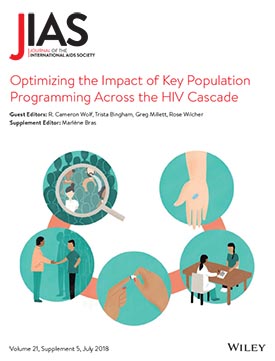In the Southern United States, there is a disproportionately high rate of HIV diagnoses amongst Black and Latino men who have sex with men. However, these groups are also less likely than their white counterparts to take PrEP, or pre-exposure prophylaxis, which can safely decrease a person’s likelihood of getting HIV through sex by about 99% when taken as prescribed.
Tagged: AIDS
-
-
To help reach the UNAIDS 95-95-95 targets by 2025, the public health community must ensure that people living with HIV have access to antiretroviral therapy (ART). Access to this lifesaving medication is one issue; staying on it is another, because continuing ART is not always possible due to a variety of circumstances. In a project FHI 360 recently concluded in Nigeria, we demonstrated how machine learning can complement the efforts of health care workers to help people stay on ART.
-
Twenty years ago, the U.S. President’s Emergency Plan for AIDS Relief (PEPFAR) was established to lead the global response to the HIV epidemic. Today, PEPFAR is a public health engine: a critical platform for strengthening health systems, preparing for and responding to pandemics, and enabling global health security. Here, we share how PEPFAR made it possible for FHI 360’s teams to effectively respond to COVID-19 in countries with established HIV infrastructure.
-
Over the past decade, there have been remarkable advances in the HIV prevention, treatment and epidemic control tools used by the global community working to address HIV. Investments in scientific discovery and implementation research have furthered our understanding of the factors driving the epidemic, as well as the biology of viral transmission. Prevention, diagnostic and treatment strategies have improved immensely, as have antiretroviral drugs.
-
While COVID-19 has been at the center of health concerns since early 2020, the fight to end HIV continues. How are HIV communicators in the United States effectively engaging with their priority audiences? Here, four HIV communicators explain why they are passionate about their work and discuss how, in the current environment, they can best reach people in the United States who historically have had to bear the largest burden of HIV.
-
Shaping the world we want to live in
An Interview with
Dr. Timothy Mastro, Chief Science Officer, FHI 360
As FHI 360 marks its 50th anniversary, explore our history of solutions and future of possibilities.
Dr. Timothy Mastro, FHI 360’s Chief Science Officer, offers his perspective on where we’ve been, where we’re going and what’s at stake in human development.
-
June 24, 2021
As FHI 360 marks its 50th anniversary, explore our history of solutions and future of possibilities.
In 1999, AIDS was the fourth biggest cause of death worldwide. And, it was the number one killer in Africa.
-
The global health community is concerned that tuberculosis (TB) continues to disproportionately kill people living with HIV, despite the availability of TB preventive therapy. According to the World Health Organization’s Global Tuberculosis Report 2019, deaths attributed to TB among people living with HIV account for 17 percent of all TB deaths, even though people living with HIV account for only 8.6 percent of overall TB cases.
-
A version of this post originally appeared on the LINKAGES blog. Reprinted with permission.
 The USAID– and PEPFAR-supported LINKAGES project is excited to announce the arrival of a new supplement in the Journal of the International AIDS Society (JIAS) titled Optimizing the Impact of Key Population Programming Across the HIV Cascade.
The USAID– and PEPFAR-supported LINKAGES project is excited to announce the arrival of a new supplement in the Journal of the International AIDS Society (JIAS) titled Optimizing the Impact of Key Population Programming Across the HIV Cascade.A collaboration among LINKAGES, USAID, CDC, amfAR, and JIAS, this supplement contributes new evidence and data-driven strategies for improving programming with men who have sex with men, sex workers, transgender people and people who inject drugs. It contains 14 original articles that represent a range of multidisciplinary efforts from diverse geographies to advance key population science and practice across the HIV prevention, care and treatment cascade.
As HIV services are scaled up in pursuit of 90-90-90 targets, investments to address the epidemic among key populations must be central to these efforts. Global data indicate that gains made among key populations lag substantially behind those made in the general population. This supplement aims to accelerate progress toward controlling the epidemic by bringing visibility to new evidence and approaches that can make key population programming smarter and more effective.
-
A version of this post originally appeared on the LINKAGES blog. Reprinted with permission.
“We will only achieve HIV/AIDS epidemic control if we reach the UNAIDS 90-90-90 targets for all ages, genders, and at-risk groups, including key populations.”
– Ambassador Deborah L. Birx, MD, U.S. Global AIDS Coordinator and U.S. Special Representative for Global Health Diplomacy, June 2018
In 2013, UNAIDS set out to establish new global targets for HIV testing, care and treatment. Stakeholder consultations were conducted at country and regional levels around the world, ultimately resulting in the creation of the ambitious 90-90-90 targets to help bring an end to the AIDS epidemic:
